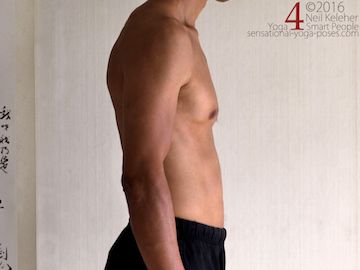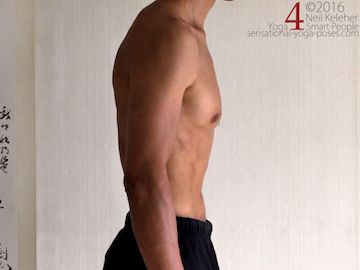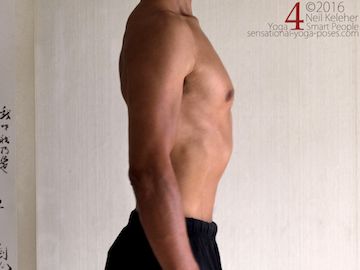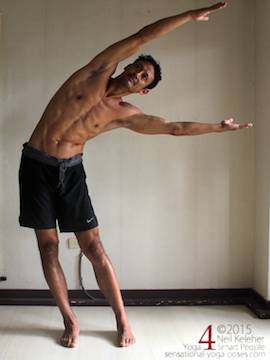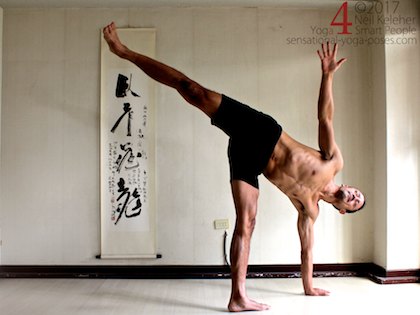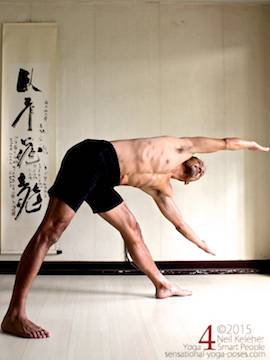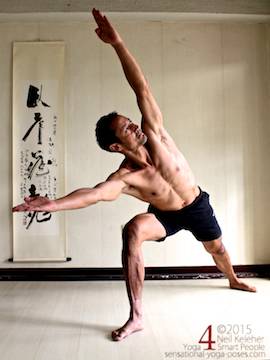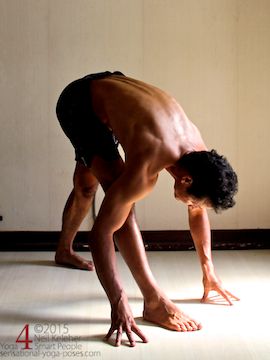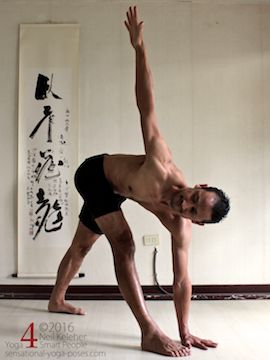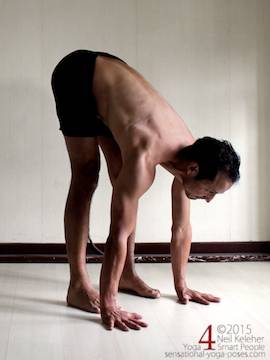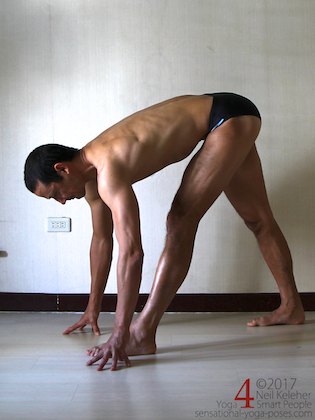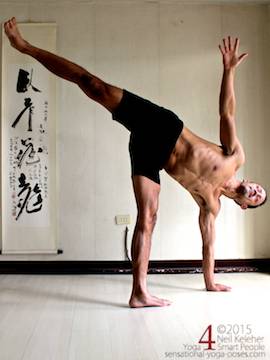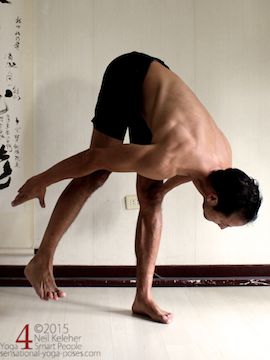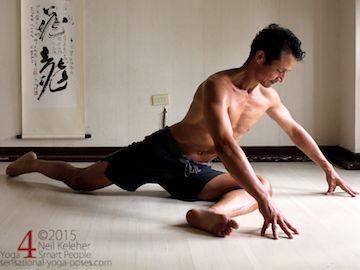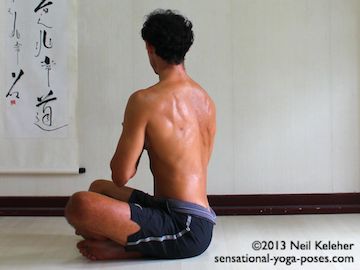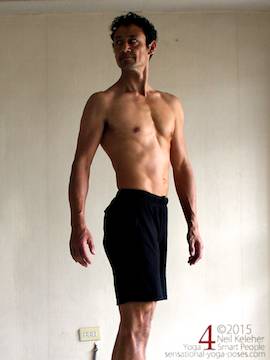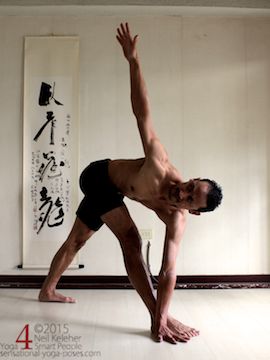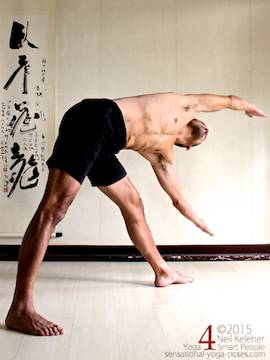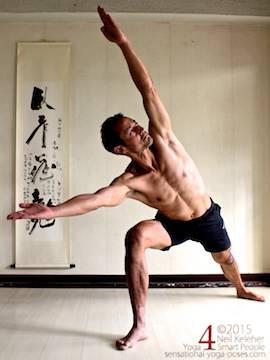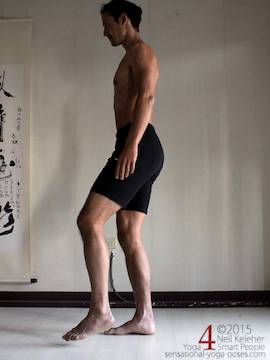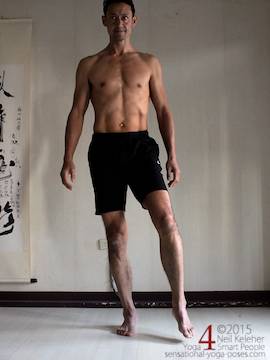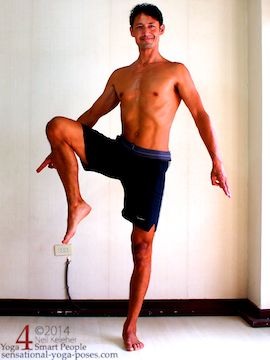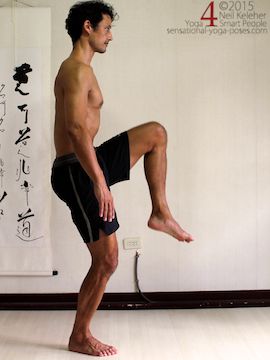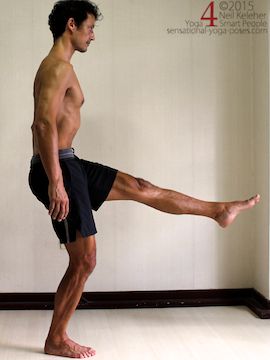The Transverse Abdominus
Of the abdominals, only the transverse abdominis directly connects to the vertebrae of the lower back. It's part of what is called the thoracolumbar fascia. The rectus abdominus and obliques (external and internal) all cross the lumbar spine but don't directly connect to it. Instead they affect it indirectly by working on the pelvis and ribcage.
Because of connections to the front points of the hip bones and to the ligament that connects these to the pubic bone (the inguinal ligament) the transverse abdominus can directly affect sacroiliac joint ligament tension by pulling inwards on the front of the pelvis.
(If your lower back pain is the result of si joint imbalance then this can be good to know. Learning to use this part of the transverse abdominus may be helpful!)
And so one exercise that may be helpful in alleviating some types of low back pain is to practice pulling the belly inwards past the border of the ribcage and pelvis. This adds tension to the paraspinalis Rectinacular sheath (in the lumbar region), the flattened tube of connective tissue that along with the back "two quarters" of the spine encases the spinal erectors. (The "back half" of each side of the spine is the area defined by the spinous and transverse processes.) Doing it as a breathing exercise, exhale while pulling the belly inwards. Inhale while allowing it to relax.
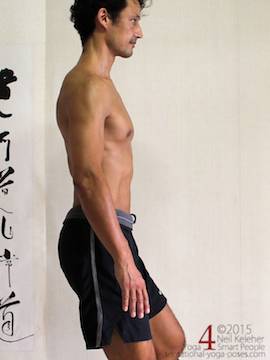
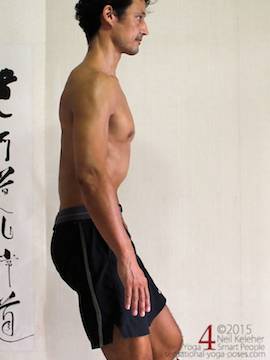
To exercise and train the lower band of the transverse abdominus practice drawing the points of the hip crests inwards. You can also experiment with pulling inwards (towards the left-right center-line of the body) on the inguinal ligaments. The idea is to use this action to pull the fronts of the two hip bones inwards. Because of the shape of the pelvis and how it connects and the pubic bone and the two SI joints, this may cause the sitting bones to spread slightly. Try pulling the upper belly in first (exhale), then pull inwards on the hip bones and inguinal ligaments as a continuation of the exhale. Release both actions to inhale.
To breathe while keeping the transverse abdominus active you could use a combination of the spinal erectors and intercostal muscles, bending the thoracic spine backwards to inhale and forwards to exhale; or you could use the diaphragm. The idea here isn't to keep the transverse abdominus pulled in at all times. However, if doing heavy exercise or extreme backbends or forward bends you may find it helpful to keep the muscle active for the duration of that exercise (assuming 5 breaths or less.)
Another breathing option is to pull the transverse abdominus inwards (exhale), then lift your chest (inhale), then relax both actions together (exhale.)
You can try this as an exercise in poses like standing side bend, half moon pose, triangle pose, triangle forward bend, twisting triangle and standing forward bend.
While doing these yoga poses you may find this action helpful or not. It depends on the particular problems that your body has.
One definite benefit of pulling the belly inwards with the transverse abdominus is that it adds tension to the superficial abdominal muscles (external and internal obliques, rectus abdominus)nmaking it easier to use them without dropping the chest (the usual result of consciously contracting the abs.) And so this action may be useful when trying to use your obliques to drive a spinal twist. (More on twisting later.)
If you've got some ability to feel and control your respiratory diaphragm, you can work at giving your lower back extra support by contracting the diaphragm downwards while keeping the transverse abdominus contracted. You may find that this creates a feeling of lengthening in your lower back. In yoga poses where the torso is horizontal, or nearly so, you may find this action gives your lower back extra support, particularly when the arms are lifted.
The Diaphragm, Psoas and Quadratus Lumborum
Other muscles that directly connect to the lumbar spine include the diaphragm, the quadratus lumborum and the psoas major.
The psoas acts on the front of the hip joint and is opposed by the gluteus maximus.
Any problems in one or the other of the hip joints can be reflected in the psoas and the quadratus lumborum. If one or the other of the psoas or QL muscles is active on one side more than the other this will pull the lumbar spine on one side. It may also cause imbalances in the pelvis and si joint twisting one hip bone relative to the other.
And so it can make sense, when dealing with low back pain, to not (just) focus on the abs, but on the hip joints instead. But before doing so you have to ask yourself, do you get low back pain while standing, or while sitting or while laying on your back? In each of these instances different motor control programs have to be active because in each case a different part of the body is the foundation. If you feel back pain while standing then it will probably be more helpful to do Standing Exercises for Low Back Pain to train your brain to activate your muscles optimally while standing so that you stop getting low back pain while standing.
Fault Finding The Cause of Your Low Back Pain
For dealing with hip imbalances, asymmetrical standing poses (on both feet or while balancing only on one foot) are probably your best bet.
One way that you can approach these types of poses is to do them slowly and mindfully so that you can feel for imbalances between the different sides.
As an example, in a triangle forward bend with my left foot forwards my left hip always feels weak when I stand up from the pose. In addition, I used to have a lot of trouble balancing in half moon pose on the left leg. Another challenging pose was doing a forward bend on one leg with the other foot lifted. The challenge here, again on the left leg was standing up from this position. (If I did have pain, then I stopped. I would then try different muscle activations to see if I could stand up without pain. Often I'd practice on my right leg, notice the sensations and then try to duplicate those sensations on the left leg.)
These poses are all ways of testing which hip is not functioning properly.
They can also be used to remedy the bad hip. Rather than doing a pose despite the pain, do the pose and experiment while in the pose to see what you can do so that the pose feels comfortable.
For myself the gluteus medius and/or minimus has been problematic and so one action that I play with is activating this muscle, particularly on the left side.
A great exercise for activating this muscle (and learning to feel it) is pigeon pose glute stretch (with the front leg hip down). Press the front knee down to activate the gluteus medius.
Twisting Poses
Twists are another way of testing hip function for low back pain. The psoas can be used to twist the lumbar spine. In addition, the gluteus maximus and the opposite side latissimus dorsai can also be recruited. (They both can be thought of as being a part of the rear layer of the thoracolumbar fascia. The sheath that wraps around the spinal erectors is part of the front layer).
Doing seated cross legged twists without using the arms to help you may find that twisting to one side is easier. Try activating the glute on the side you are twisting away from. A simple way to do this is to press the foot down into the floor. Try activating the lat on the opposite side (to the glute) also. Twisting to the right, activate the left glute by pressing the left foot down. Then also activate the right latissimus dorsai.
You can carry this technique into the standing twist.
Twisting to the right, activate the left glute and optionally the right latissimus dorsai. In this case the pelvis will twist also, but try to carry the twist up the spine so that the lumbar, and thoracic spine twist also.
In twisting triangle you can use the same action. With the right leg forwards and twisting to the right, activate the left gluteus maximus. To activate the right latissimus dorsai try pulling the right arm rearwards while keeping it vertical.
Using Lateral Standing Poses for Low Back Pain
Since the psoas opposes the gluteus maximus (and vice versa) faulty gluteus maximus function can also affect the psoas. And glute maximus may in turn be affected by the hamstrings which also work on the back of the hips as well as the backs of the knees. (And because of that, if you still have low back pain problems despite working on the hips, you might also find it helpful to look at using the calfs to stabilize the backs of the knees. This is covered in the Extreme Stability for Yoga.)
And so some low back pain for working with these muscles are triangle and side angle.
These poses can be done in such a way to actively train psoas and quadratus lumborum. Again the first task can be to see if one side feels different than the other. From there try activating glutes and hamstrings of the front leg. Then relax and activate quads and hip flexors instead.
Note that when entering these poses I'd suggest dipping the front leg side of the pelvis so that the pelvis leans towards the turned out foot. In addition lift the tailbone so that the pelvis tilts forwards and the lumbar backbend (or lumbar lordosis) is increased.
Balancing Exercises for Low Back Pain
When practicing balancing on one foot, the first exercise can be to balance with the other foot an inch or less off of the floor.
Look for differences in foot activation which can lead to the knee of the supporting foot rolling inwards or outwards. Also look for differences in where you habitually press through the standing foot. From there work your way up to the hips looking at pelvic tilt, and differences in glute activation. You could use the same side glutes to keep the pelvis level. However to compensate you may find the opposite side obliques activate.
Working towards fake tree you can see if you can lift the knee higher on one side or the other. Again while doing so look for differences in sensation and work on the less good side to make the sensations equal.
With the foot against the inner thigh again look at differences in hip height between the side. Does the pelvis lean more on one side than the other?
Eagle pose (without the arms wrapping each other) is another possible fault finding and remedial pose. Is it easier to lift the hip on one side than the other prior to entering the pose? Is internal rotation (that leads to hooking the foot) easier on one side than the other?
Even if you can't hook the foot, the simple action of holding the pose with the foot unhooked and working at internal rotation can be a good way to exercise and restore balance to the hip and leg muscles, and thus the lower back.
Hip Flexing for Psoas Function
Going back to the psoas, a good way to exercise and test psoas function is to flex the hip.
Generally I like to start with bent knee hip flexion. But prior to this, the exercise I add is dropping the tailbone to round the back so that the psoas has room to contract. Next, try it while lifting a straight leg. If your rectus femoris cramps that's a good sign the psoas isn't activating. Try rotating the leg inwards or outwards and then try moving the leg inwards or outwards slightly.
Also notice if your ribcage is twisting or displaced sideways slightly with respect to the pelvis. This can be indicate whether there is imbalance or ill function in one side of the waist/hip structure. It may also be a habitual alignment that you can correct rather simply by twisting or displacing in the opposite direction. How do you know if you've done enough? When the rectus doesn't spasm.
Published: 2020 08 13



